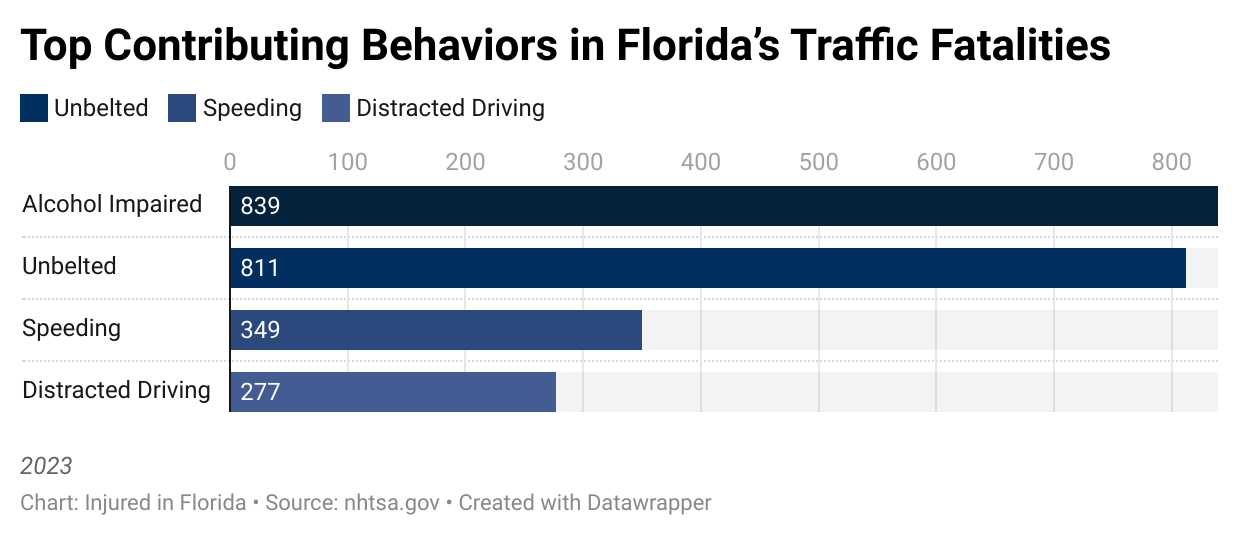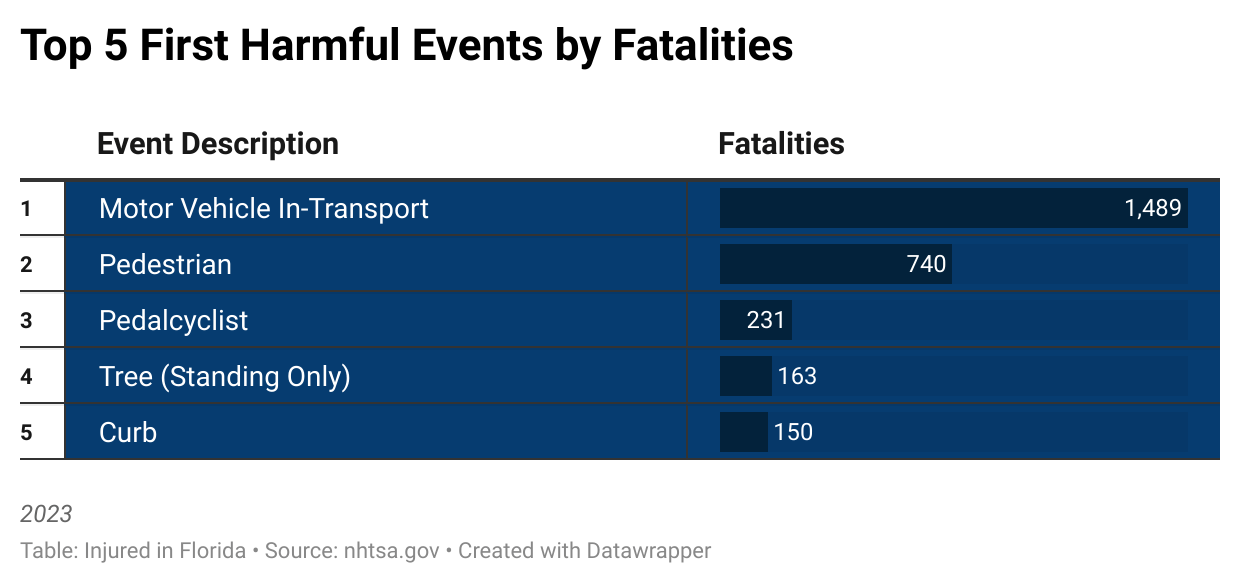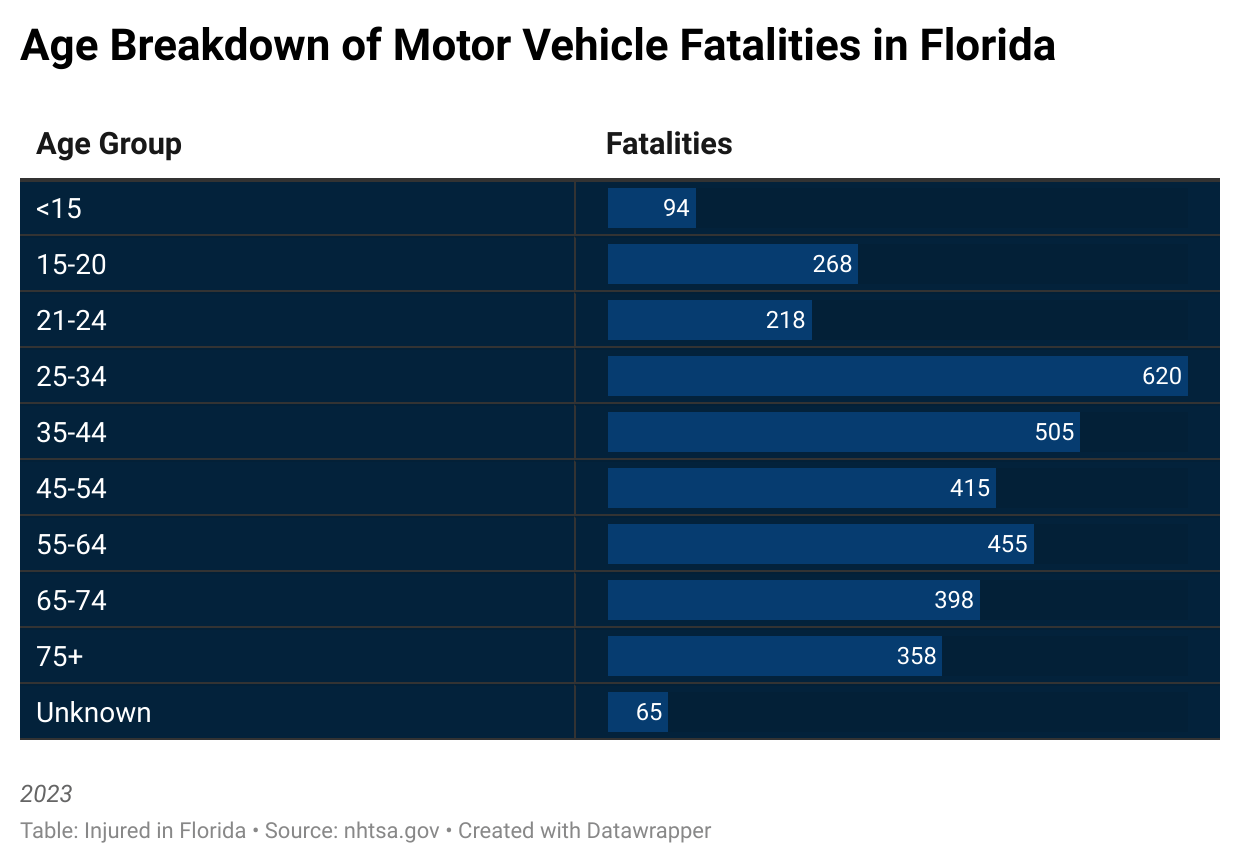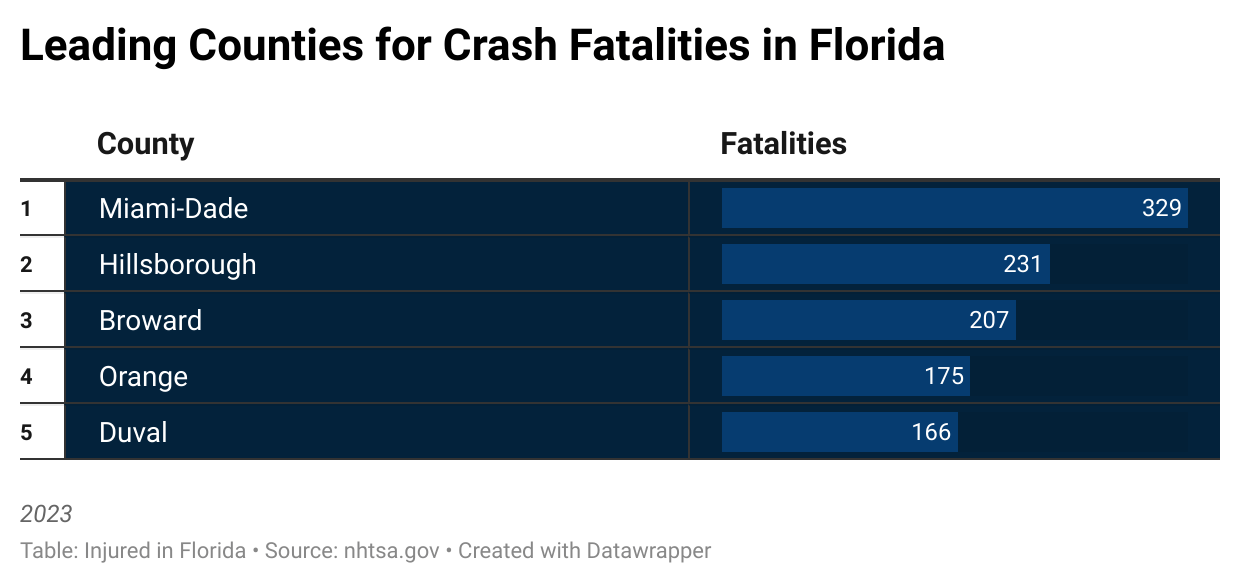Florida’s a huge state (22.6 million residents) that attracts vast numbers of tourists each year (140 million in 2023), eager to check out its beaches, theme parks, and nightlife. One consequence of both factors is the inevitable busyness of the roads in the Sunshine State, which also means a significant number of motor vehicle accidents. But what are the main causes of road accidents in Florida?
This study will answer the question, and look into why those causes so often occur, who’s responsible, which areas represent the most danger to Florida drivers, and some measures that would help prevent thousands of needlessly lost lives.
The Main Causes Of Road Accidents In Florida
Drunk Drivers
Study data tells us that one urgently needed measure is a means of preventing drunk drivers from getting behind the wheel in Florida, since this is the main cause of accidents and fatalities in the state.
Of 3,396 total motor vehicle fatalities in Florida – a number that represents 8.3% of the 40,901 total motor vehicle fatalities nationwide – 839 were due to drunk driving.
Other Key Road Accident Factors

Beyond drunk driving, the data presents a sobering picture of the other (highly preventable) behaviors most commonly linked to fatal crashes on Florida’s roads.
There were 811 unbelted occupant fatalities, meaning a failure to wear a seat belt was nearly as deadly as drunk driving. Combined, the two categories represent over 1,600 deaths, or 48.6% of all motor vehicle fatalities in the state: numbers which betray bad habits that persist despite decades of public safety campaigns and law enforcement efforts.
Speeding is another well-documented risk factor: in this case, it was the cause of 349 fatalities. Such numbers reinforce the reality that driving at high speeds not only increases the likelihood of a crash but also dramatically worsens the potential outcome.
Distracted driving, which includes texting, eating, and adjusting in-car devices, led to 277 deaths. While it ranks lower than the other behaviors, distracted driving is a growing problem as devices become more ingrained in everyday habits.
Combined, these fatality causes make it clear: drivers make many choices and exhibit many different types of behavior that have life-or-death consequences.
The fact that alcohol use, failure to use a seat belt, speeding, and distraction continue to dominate fatal crash statistics suggests an urgent need for targeted intervention.
This means better public education, more high-visibility enforcement, and the universal adoption of technology-driven solutions like speed cameras or seat belt alerts. Most importantly, the data reveals that many of these deaths are not mere happenstance or bad luck, but are instead the direct result of risky and often illegal behavior that must be addressed through smarter policy and stronger accountability.
‘First Harmful Events’
The term ‘first harmful event’ refers to the first sequential event in a traffic accident that causes injury, death, or property damage. This event could be a collision with another vehicle, a pedestrian, a fixed object like a tree or guardrail, or it might involve something like an overturned vehicle.

Study data reveals that by far the most common ‘first harmful event’ on Florida roads – causing 1,489 deaths – was a collision during which a moving motor vehicle was the first point of impact.
This signifies high-speed environments, heavy traffic zones, and multi-vehicle interactions as critical contributors to fatal outcomes.
Additionally, pedestrians accounted for 740 fatalities as the initial harmful event, underscoring Florida’s enduring challenges when it comes to walkability, crosswalk safety, and driver awareness. If we add those numbers to those of pedalcyclist fatalities (231), it’s clear that Florida’s most vulnerable road users – those not protected by a vehicle – face disproportionate risk.
Particularly concerning is the number of fatal crashes that involve fixed roadside objects, especially trees (163 fatalities) and curbs (150 fatalities). These figures suggest that loss of vehicle control plays a significant role in deadly incidents, probably due to speeding, distraction, impaired driving, poor road design, or a combination of these factors. And, a fatal encounter with a curb or tree as the first point of impact suggests that even non-collision objects can be deadly.
These trends highlight a critical need for improvements to both infrastructure safety and driver behavior. This is especially true in areas where high speeds, poorly lit roads and pavements, or insufficient pedestrian protections are an issue.
Ultimately, the data tells us that Florida’s fatal crashes are about much more than what’s happening inside the vehicle, and often depend on the first point of impact during an accident. And, whatever the reasons for a fatality, men are apparently far more susceptible.
Crash Fatality Gender Disparity
In fact, men in Florida are far more likely to be killed in motor vehicle fatalities than women. Of 2023’s 3,396 road fatalities, 2,250 were men, with women accounting for 842. (There were also a number of ‘unknown’ and gender-unconfirmed fatalities: this type of statistical discrepancy is common in large-scale crash datasets, and may be due to incomplete reporting, pending investigations, or data entry limitations.)
Simply put, men indulge in far riskier driving behaviors like speeding, drunk driving, and not wearing seatbelts. Male attitudes to mental health may also play a role: men are statistically far less likely to seek help for stress, depression, or emotional struggles, which can subsequently manifest in reckless or impulsive driving. Men also log significantly more driving hours than women.
Taken together, these factors largely explain the comparatively high male fatality rate, which makes the gender disparity as much a public health issue as a traffic safety one.
Crash Fatality Age Ranges

Of Florida’s road fatalities, 25-34 year-olds represented the group with the highest number of traffic fatalities in 2023 (620 deaths), followed by 35-44 year-olds (505), and 55-64 year-olds (455). This shows that young and middle-aged adults (particularly those in their working and commuting years) are most frequently involved in fatal crashes, largely due to more time spent on the road, higher exposure to danger, and riskier driving behaviors.
Notably, younger drivers (15-20 year-olds) accounted for 268 deaths, with 21-24 year-olds adding another 218. This confirms that drivers in their late teens and early twenties remain vulnerable, due to a combination of inexperience, speeding, and drunk driving.
At the other end of the spectrum, 756 adults aged 65+ died in car accidents, highlighting that seniors remain substantially at-risk, due to slower reaction times, vulnerable health conditions, and increased impact fragility.
Children under 15 accounted for 94 fatalities, underscoring the importance of child passenger safety and pedestrian protections near schools and residential areas. Lastly, 65 fatalities were listed as ‘unknown’, reminding us that crash data often includes minor statistical lacunae.
Overall, Florida’s age-related crash fatality data shows that younger and middle-aged adults are dying in the highest numbers. That said, every age group faces significant risk on Florida roads, and all would benefit from targeted safety messaging, better levels of enforcement, and infrastructure planning that’s more conscious of road fatality risk. On that note, the following counties would surely also benefit from similar measures.
Main Florida Crash Counties

In 2023, five Florida counties stood out as the most dangerous for drivers and accounted for a significant portion of the state’s 3,396 motor vehicle fatalities.
Topping the list was Miami-Dade County with 329 traffic deaths, reflecting the challenges of navigating one of the state’s most densely populated and heavily trafficked regions.
Next up was Hillsborough County (231 fatalities), home to the Tampa metro area, and Broward County (207). These counties, anchored by major cities, complex highway systems, and fast-paced urban commutes, face consistently high crash risk due to the sheer volume of daily drivers on congested roadways.
Orange County, which includes Orlando and is a major tourist hub, ranked fourth (175 fatalities), while Duval County, home to Jacksonville, rounded out the top five (166).
Together, these five counties were responsible for over 30% of Florida’s traffic fatalities in 2023, underscoring how population density, tourism traffic, and urban sprawl contribute to heightened road risks. These figures highlight the urgent need for targeted safety interventions, infrastructure improvements, and public awareness campaigns in Florida’s busiest and most crash-prone regions. Ultimately, safer places to drive are more likely to earn tourist dollars.
Florida Tourist Hubs
The five Florida counties with the highest number of traffic fatalities are also home to some of the state’s biggest tourist attractions and significantly contribute to consistently high traffic volumes.
In Miami-Dade County, visitors flock to its iconic beaches and South Beach nightlife, a global hotspot known for its vibrant energy and art deco flair. Hillsborough County draws thrill-seekers to Busch Gardens Tampa Bay, a theme park that blends roller coasters with up-close animal encounters. In Broward County, Fort Lauderdale Beach’s sunny shores and bustling boardwalk atmosphere are its main attractions.
Orange County is famous for the world-renowned Walt Disney World Resort, which draws millions of tourists every year, turning Orlando into one of the busiest parts of the U.S.
And Duval County entices beach lovers to Jacksonville Beach, where ocean views and outdoor activities keep its roads packed year-round. These attractions highlight the role tourism plays in shaping traffic patterns and inevitably increasing crash risk in Florida’s most visited regions.
Curbing Bad Florida Road Habits
In 2023, Florida recorded 3,396 motor vehicle fatalities – 8.3% of all traffic deaths nationwide. With a population of over 22.6 million and an estimated 140 million annual visitors, the Sunshine State sees some of the heaviest traffic in the country and a high number of deadly crashes.
The leading causes (by far) of these fatalities were drunk driving (839 deaths) and unbelted occupants (811 deaths). Combined, the two factors represented nearly 49% of all traffic-related deaths in the state. Other major contributors included speeding (349 fatalities) and distracted driving (277 fatalities), illustrating how driver choices continue to cause preventable tragedies.
When examining ‘first harmful events’ regarding Florida’s fatal crashes, collisions with moving vehicles (1,489 deaths) were most common, followed by contact with vulnerable road users such as pedestrians (740) and pedalcyclists (231).
Fatal crashes involving fixed objects like trees (163 fatalities) and curbs (150 fatalities) were also prominent, pointing to loss of driver control and poor roadway design as likely factors. Young and middle-aged adults, particularly those aged 25 to 34, suffered the highest fatality rates, while men made up the vast majority of all deaths.
There were 811 unbelted occupant fatalities, meaning a failure to wear a seat belt was nearly as deadly as drunk driving
Florida’s five most populous counties (Miami-Dade, Hillsborough, Broward, Orange, and Duval) collectively accounted for over 30% of the state’s traffic deaths.
These areas are not only the most densely populated, they’re also home to some of Florida’s biggest tourist attractions (South Beach, Walt Disney World, Busch Gardens, and Fort Lauderdale Beach). This intersection of high population, heavy tourism, and complex road systems contributes to intense daily traffic volumes and increased crash likelihood.
Altogether, the data paints a clear picture: Florida’s traffic fatalities are driven by a combination of risky behaviors, infrastructure challenges, and population (tourist and residential) pressure.
To get these numbers down, Florida must invest in targeted public education, high-visibility enforcement, road and pedestrian-area improvements, and policies that address both driver behavior and environmental risk factors. Without intervention, the state’s most popular roads may also remain its deadliest.
At The Schiller Kessler Group, our personal injury team is dedicated to helping you if you’ve been injured by the negligence of others. We take an aggressive approach to personal injury representation, fighting tirelessly to get you the compensation you deserve.
Get in touch with us today for more information.

